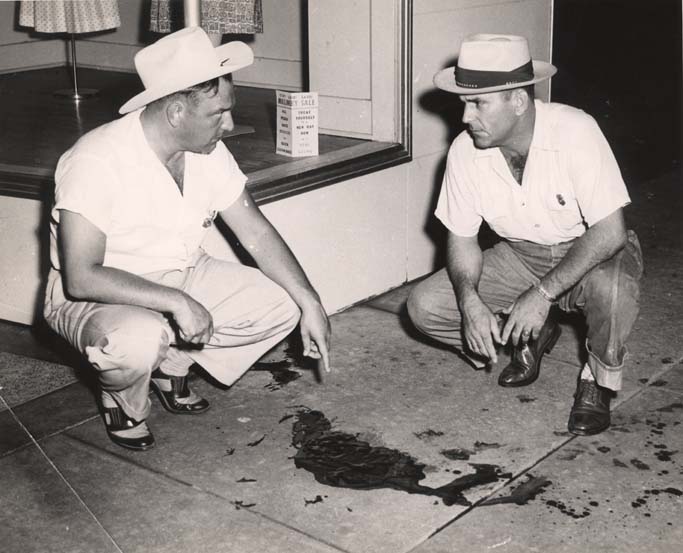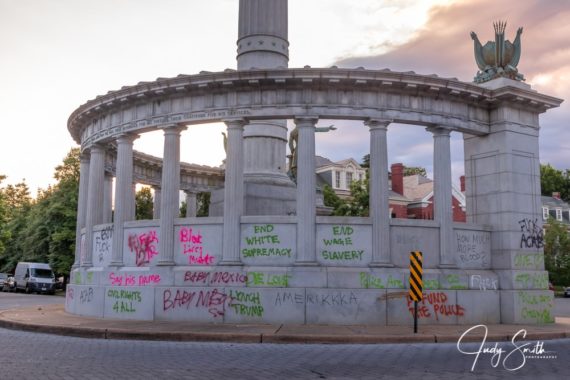On June 18, 1954, Albert Love Patterson, attorney general nominate for Alabama, was gunned down while getting into his car in a dark ally in Phenix City, Alabama. He had campaigned for months on a pledge to clean up corruption and organized crime in the State, but principally in Phenix City, a town once called the “wickedest city in America.” Just a few days before, he told a women’s club that he would not live to be sworn in.
The town soon became a media circus with several news magazines doing cover stories. By 1955 a feature film on the murder, “The Phenix City Story,” had been produced. Just before the film opened in Phenix City, the movie theater burned down.
Organized crime constituted a $100 million annual business in Phenix City (in 1954 dollars), and the town was a major tourist attraction for gamblers from all over the country. Men would fly into Columbus, Georgia to frequent one of the dozens of casinos or brothels on the other side of the Chattahoochee River. Almost all of the illegal establishments lined the Phenix City side of river, but Columbus also had its fair share of women of the night, and a few brothels could be found in the nearby Alabama countryside.
Phenix City had a dice factory, a playing cards factory, and several bootleg liquor operations. The crime syndicate would send duffel bags stuffed with cash on a regular basis to Montgomery to influence politicians, in particular the Alabama Attorney General, S.I. Garrett, later indicted in Patterson’s murder. It has been suggested that Phenix City controlled all organized crime in the Southeast, from alcohol, to prostitution, to drugs. Young, unwed pregnant girls would come to Phenix City to sell their babies on the black market and sometimes would end up in the prostitution trade.
Organized crime also bought off the local population. The police were in their pocket, and when the high school band needed uniforms or the poor children of the city needed a Thanksgiving or Christmas turkey, they paid for it. They provided jobs and later a hospital for the city, which was just torn down this year. No need to worry about “illegal” activity when the police would look the other way, and when lottery ticket holders would walk over dead bodies to redeem their tickets (this happened after a building collapsed and several people were crushed). Much of the population of the town either needed or wanted the crime syndicate in their backyard.
Phenix City had always had a nefarious reputation. When Columbus was incorporated in 1828, a settlement grew on the other side of the Chattahoochee occupied primarily by those who wished to skirt the law. The Creek Indians still controlled parts of the Alabama side and they often looked the other way when bandits, drunks, prostitutes, and other less than savory types set up camp. People in Columbus called this settlement Sodom, and every so often these thugs would ride across the bridge into Columbus, loot the city, and then escape across the River. Law enforcement faded away when an attack appeared imminent and returned when the outlaws were safely back in Alabama.
By the late nineteenth and early twentieth centuries, Phenix City was better known as a mill town. Many of its residents worked in the Eagle and Phenix Mill across the river in Columbus (the original Eagle Mill was burned by Yankees in 1865), hence its name. Phenix City still had a flourishing underground liquor operation–future Supreme Court Justice Hugo Black was photographed digging whiskey out of a Russell County farm around 1910–and organized crime was around, but nothing like it would be in the years after the U.S. Army came marching to town after World War I.
In 1918, the United States government established Camp Benning, named after Confederate General Henry Benning, in Columbus. The city was behind the move and ultimately donated thousands of acres of land to the project. The army “bought” thousands of more acres of land in Georgia and Alabama to add to the post. Some of this real estate was the best farm land in the region and the ruins of few old plantation homes still sit as ghostly reminders of days gone by on Benning property.
Camp Benning was renamed Fort Benning in 1922 and had near 8,000 soldiers on post. It became the primary infantry training center for the United States Army–Dwight Eisenhower, George C. Marshall, and George Patton among others trained men there–and by World War II over 100,000 men received basic training at Fort Benning.
Young soldiers wanted to blow off steam, and with a short bus trip could be in Phenix City, pawning their boots, drinking illegal liquor, throwing dice, or cavorting with night girls, some of whom had the initials of their brothel tattooed on their inner lip. Benning, and its endless supply of young men, made Phenix City hum. “Grocery” stores without a grocery item on the shelves became goldmines as soldiers blew their money on rigged slot machines, loaded dice, and marked cards. That was in addition to the dozens of lottery drawings in town. Yet, as long as the money flowed to politicians and crooked law enforcement, Phenix City’s multi-million dollar crime syndicate operated with little interference. In fact, crime solved the budgetary problems the city faced in the 1930s. The city passed several licensing laws for liquor and gambling business and collected thousands of dollars in revenue, but never enforced the codes.
Those who did try to clean up the town before 1954 took a manly and courageous stand against vice. One had his home burned down, another had his front porch dynamited with his family inside, and others were arrested or beaten for “disturbing the peace.” Elections were rigged to keep organized crime in control of the city. That was until 1954 and Albert Patterson.
Patterson was a World War I veteran and proudly discussed his Confederate ancestors (listen to his campaign speech below). He grew up on a farm in middle Alabama and was active in civic organizations. He was elected to the Alabama legislature and never missed a vote–a rare occurrence in American politics today. By the 1950s, he had a private practice in Phenix City and had become disgusted with the stranglehold organized crime had on his adopted town. Patterson joined forces with local activists in the Russell Betterment Association to stamp out vice and corruption. He once said Phenix City organized crime was what happened when good men do nothing. His decision to run for attorney general led to his death, but his sacrifice proved to be the needed push to clean up the town.
His son, John Patterson, eventually took his place as Attorney General and got to work rooting out organized crime in Phenix City. Governor Seth Gordon Parsons declared martial law and the Alabama Guard moved in to break up the casinos, brothels, and illegal operations. Prostitutes fled like cockroaches under a light. Slot machines still loaded with money were dumped into the Chattahoochee. Casinos shut their doors with many closed by force. Even Alabama guardsman were surprised by their haul of gambling implements.
John Patterson also focused on finding his father’s killer. When the governor refused to act, Patterson traveled to Washington to see FBI Director J. Edgar Hoover. Hoover said this was a local matter, but no one knew that. When Patterson arrived back in Phenix City, he told the press that Hoover promised to get to the bottom of the murder. That set everything in motion. Several men were eventually implicated and arrested and one went to prison for life. He was found dead in his cell a few years later. One witness to Patterson’s murder was stabbed to death waiting for a bus. S.I. Garrett wound up in a Texas mental hospital to avoid prison. Patterson later said he never felt safe in Phenix City and carried a loaded gun at all times. The majority of the people, however, were behind him and his crusade to exact justice.
By 1955, the organized crime syndicate had been removed from power and Phenix City’s political and business climate changed. Look magazine designated it an “All-America” city the same year.
Phenix City had a checkered past, but one made more seedy by the influence of federal money and a standing army. Perhaps, though, Phenix City could have avoided many of the problems that led to Patterson’s death had it developed like the rest of the region around farms and factories rather than casinos and bootlegging. Phenix City was as much a byproduct of Reconstruction as any carpetbag government or business in the South. In order to generate revenue, it turned to a guaranteed clientele after the establishment of Fort Benning. Its eventual clean-up was a testament to good, Christian people determined to eliminate vice and take their town back. One historian later called them “A People Courageous.” That courage, more than the vice and crime that blackened the city’s name, is a testament to Southern character and tradition. The New South had been stamped out by the Old.







